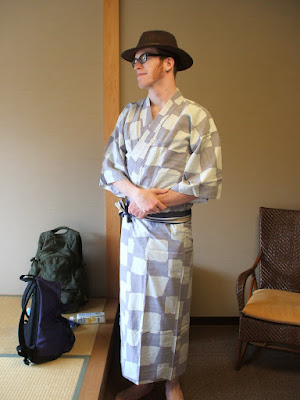So, as a matter of unfinished business, I want to make a statement:
To Mike Rondhuis, my former OSU roommate,
I'm sorry for what I put you through. I hope some day I can make it up to you, all the nights my friends and I kept you up, or teased you about being stuffy. You deserve a sainthood for not smothering me in my sleep for the year and 2 months we lived in that West Hall dorm room.
Well, Shall I start where I left off last time? It seems so long ago now, back before the weather became colder, the wind became stronger, and the rain began to fall. I hope my memory will serve me long enough to complete my story.
 |
| From Study Abroad: AIU |
Our time or rest and relaxation at Tazawako had come to an end. We had originally planned to then go strait back to Akita City and get back to our daily grind. We had not planned to pick up the spirit of adventure somewhere along the way however, and when the spirit of adventure grabs hold, I'd rather not shake it loose. Sakie suggested we make a pit-stop on our way back to Akita City; the stop in between Tazawako and Akita: Kakunodatte.
 |
| From Study Abroad: AIU |
Kakunodatte is famous in the Tohoku region for being a "Samurai Village". While there were few Samurai who lived here all year long, it was a place where they stored their "Koku", or the product of the land they were given as payment for their services to their Daimyo. A samurai's place in the pecking order was heavily influenced by their "Koku". Now you can better understand the size of the doors they put on their store-houses:
 |
| From Study Abroad: AIU |
The main draw of tourists to Kakunodatte is not, of course, the plain, white-washed store-houses of Tohoku Samurai. It is the way that Kakunodatte has changed, or more accurately, how it hasn't changed, that draws people in.
 |
| From Study Abroad: AIU |
The houses in Kakunodatte are preserved, or rebuilt, the way they were hundreds of years ago when they were first built. It brought to mind the trip my family took many years ago to Colonial Williamsburg, in Virginia, where a small town shared a similar theme. Unfortunately, unlike that small village in Virginia, Kakunodatte is a recreation in architecture only. Upon closer inspection, the people occupying most of the houses are clothed by the GAP or Levi, and many of the buildings that once held tons of rice and grain now hold souvenir shops or restaurants. A few however do house museums, a nice glance back at the way things once were before the Meiji restoration crept it's way North into Tohoku.
 |
| From Study Abroad: AIU |
 |
| From Study Abroad: AIU |
When walking through the garden of one of these old properties, one could easily forget that there is a bustling world on the other side of the tall fence. Well, unless you 6'4", in which case you can actually see what is on the other side of the tall fences without much effort.
 |
| From Study Abroad: AIU |
 |
| From Study Abroad: AIU |
On one of the boards located in the largest garden Sakie and I came across, it stated that a handful of the flora located in the gardens at Kakunodatte is one of a kind, not found anywhere else in the world.
 |
| From Study Abroad: AIU |
 |
| From Study Abroad: AIU |
Kakunodatte is famous for one more thing, and it is something that the Japanese hold head and shoulders above Kakunodatte's historical value: it is home to a 1km unbroken stretch of hanging cherry blossom trees. This stretch of trees has made an appearance in more movies world-wide then most directors would care to admit, and is considered among many as the pride and joy of the Tohoku region. Ladies and Gentleman, I present to you:
 |
| From Study Abroad: AIU |
Absolutely nothing! The blossoms on cherry blossom trees (called Sakura) only bloom for a couple of weeks every spring. Sakie and I came to Kakunodatte a few weeks late. By that time the blossoms had bloomed, fallen from the trees, had been vacuumed up, and sold off to be put into scented soaps, craft papers, and made into an ice cream flavor. Oh well, we still had a chance to take a nice 1km walk along a river in the shade of some trees. When we were came to the end of the shady tunnel, we knew it was time to be getting back. We had enjoyed our fill of local cuisine, seen all that the place had to offer, ran from giant spiders (seriously, the size of a baseball!) and taken in enough sun to last us through the winter. We hopped back on the bullet train headed for Akita Station and promptly fell asleep.







































